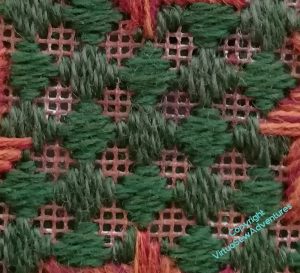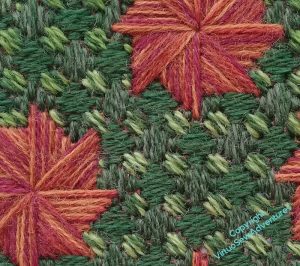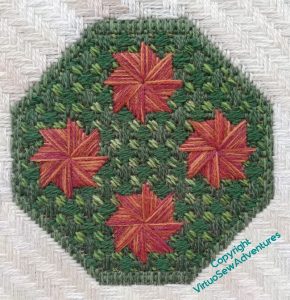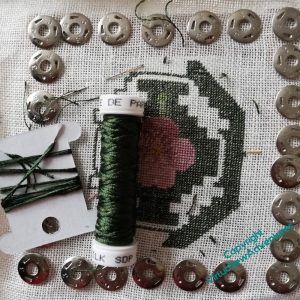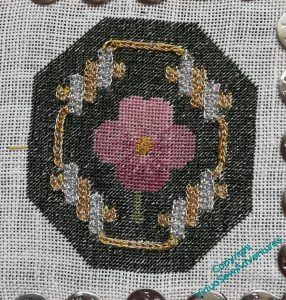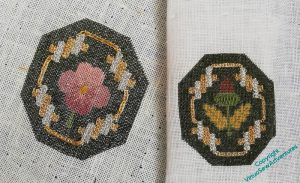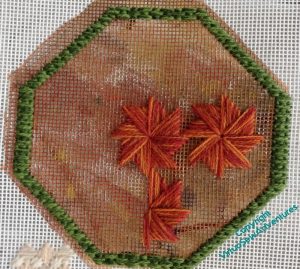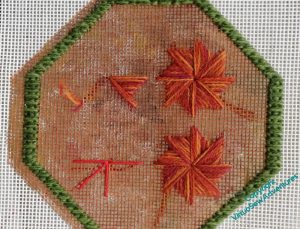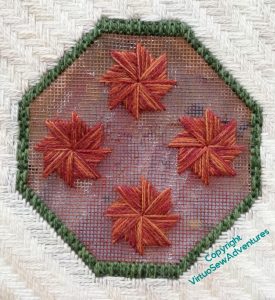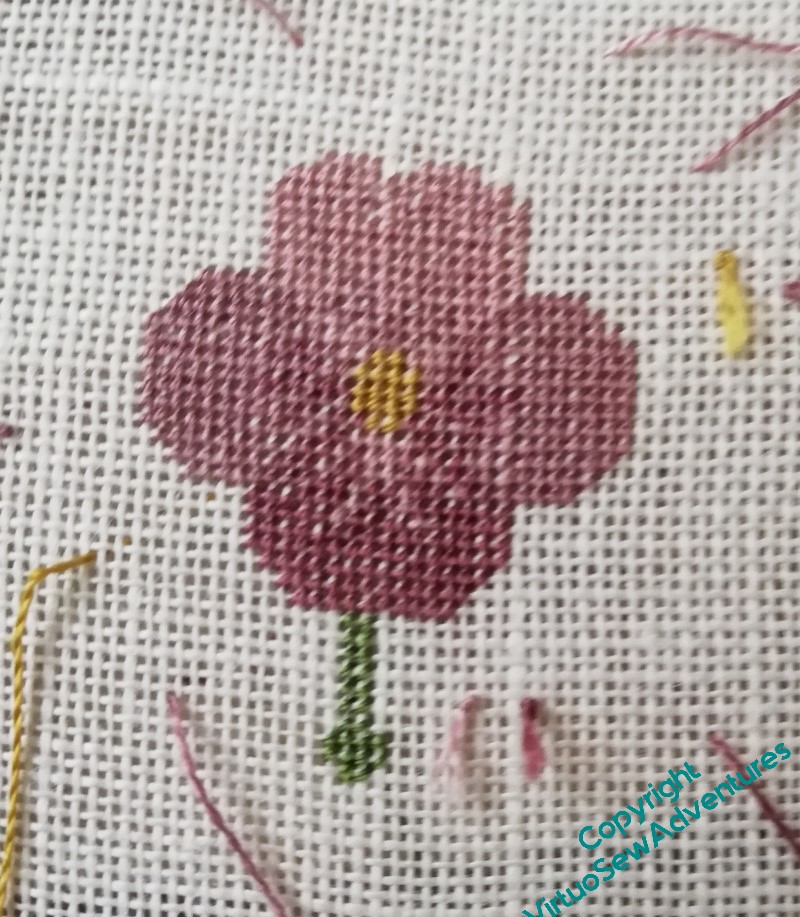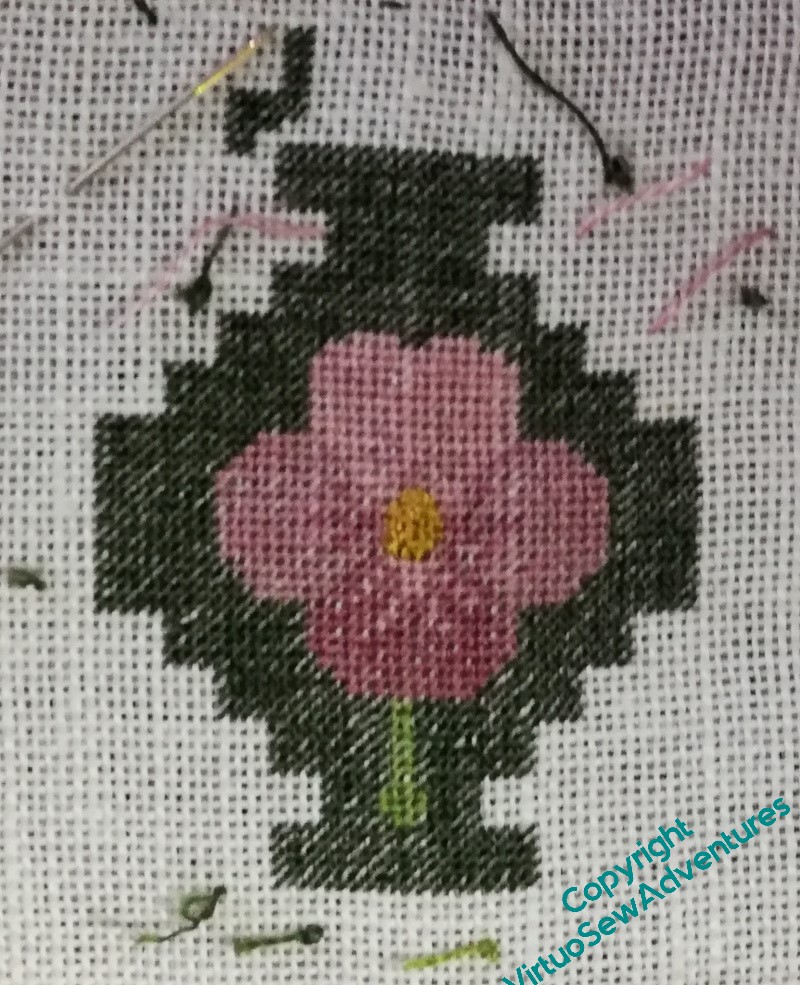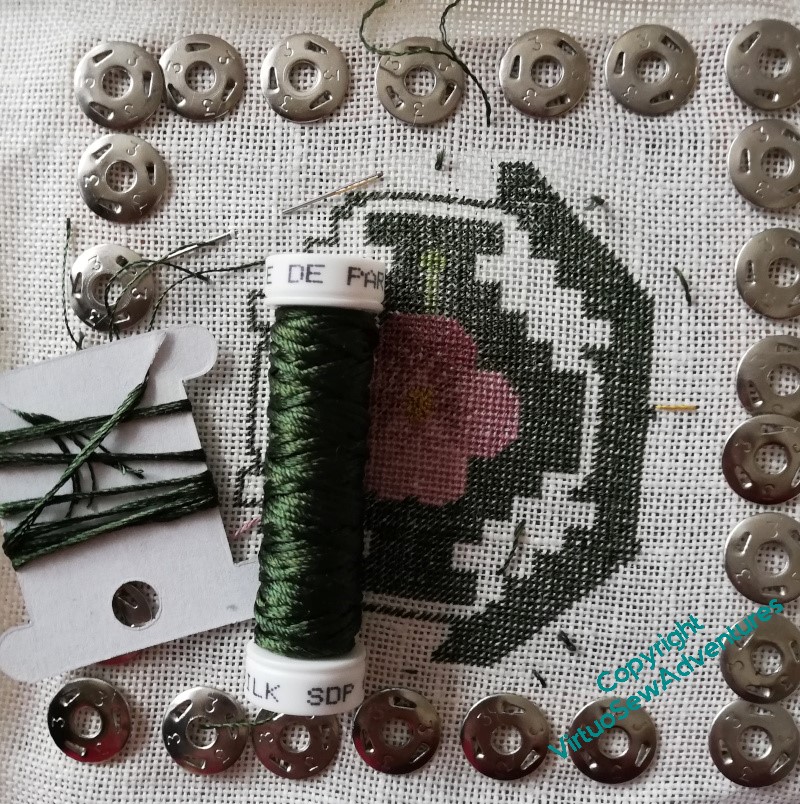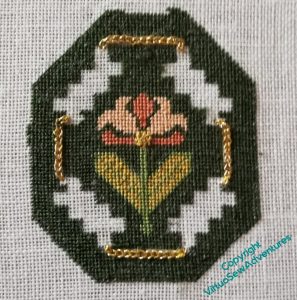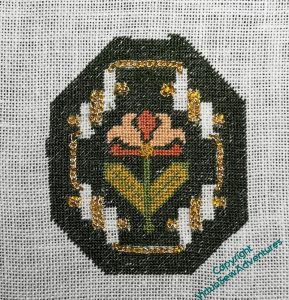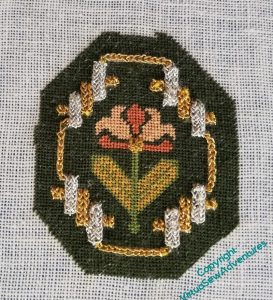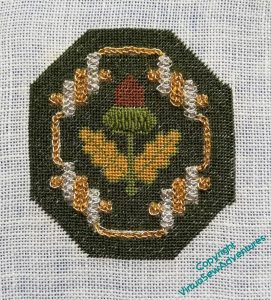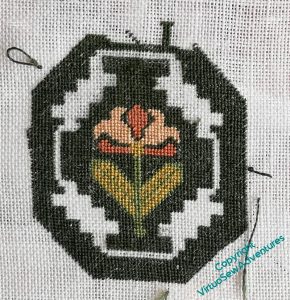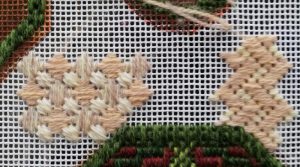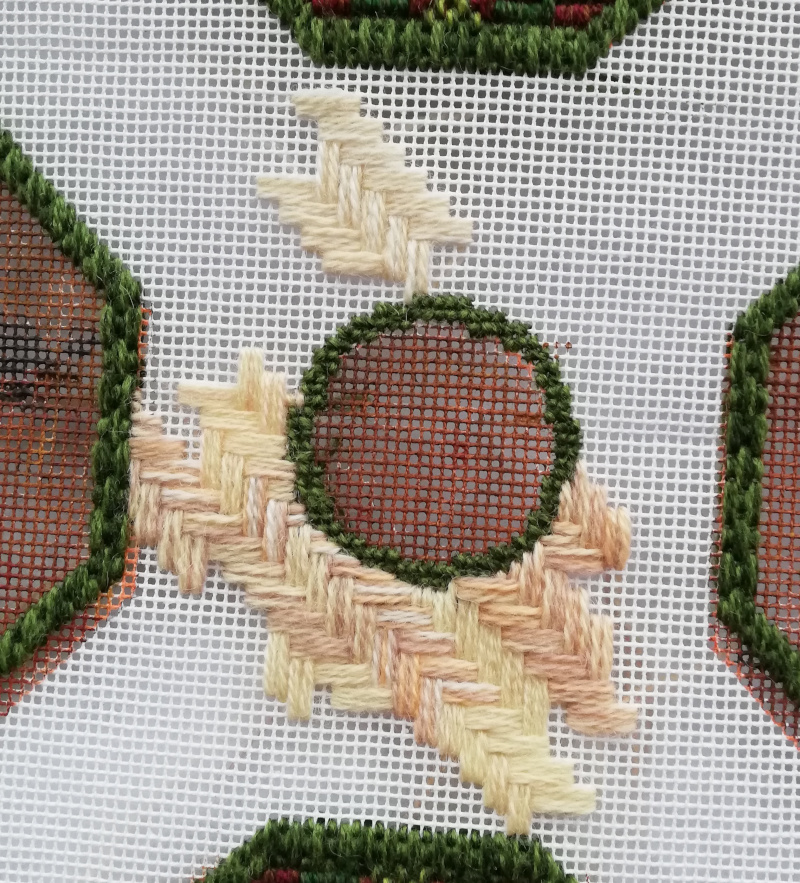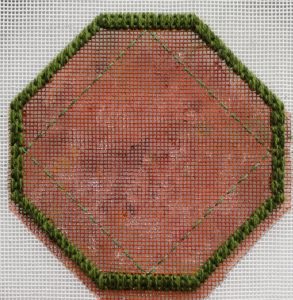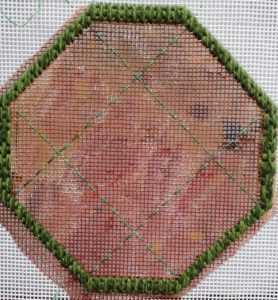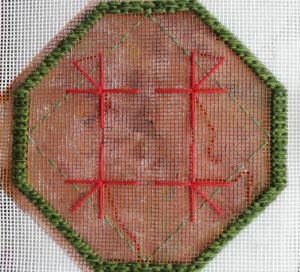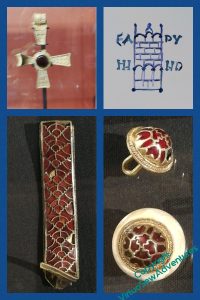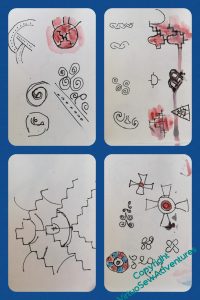Category: General Embroidery
Parterre Progress
Interior design involves balancing places for the eye to rest with things for it to look at, but having that happen at different scales and different distances from the eye means that you can have just as much visual excitement as you want.
Once I put my “hero” stitches – the pinwheels – in the octagonal borders, I needed to find something to surround them. It needed to be much quieter, to allow the heroes to be truly heroic, but at the same time, I wanted something that would be visually interesting if you bothered to look.
This is the first two stages of Palace Stitch, which was one of the stitches I interviewed for the limestone pavement. Heathering the yarns means that even close up you have something to look at, and it helps me eke out my stash of Paternayan, too. It’s too beautiful not to use, but doing a large project is becoming something of an exercise in invention!
The final stage of Palace Stitch involves small squares of diagonal stitches. Again I have heathered yarns, this time using lighter, yellowy greens.
The placement of all my colouring variations isn’t quite exact, but I like it that way. Plants don’t grow identically, and a lot of the charm of knot gardens and parterres lies in the crisp shapes with the subtly varying colours of the plants filling them. I’ve been trying to paint hillsides and forests of late, and I never thought I’d say this, but the canvaswork is easier!
I think this is a success. The slightly lighter centre, the darker edges, and the varying colours of the pinwheels (four different shades of Appletons Crewel Wool held together) all create a varying effect which is properly geometrical and definitely canvaswork while still managing to be vaguely horticultural.
I do like it when a Plan comes together!
Golden Accessories – Pansy
The Pansy continued apace, with only one alarming period when I thought the small amount on the card was all I had left to finish the dark green.
Then I found an entire full reel, gleaming at me from the bottom of the project box.
I was greatly relieved, to say the least!
Next, however, on to the gold and silver.
Some of this echoes the other two, and was fairly easy to put in place – reverse chain stitch in the narrow sections. I learnt from last time, however, and this time I put the silver strapwork panels in before the gold, which was again Ceylon Stitch.
The silver was reverse chain stitch with buttonhole edging – so it’s the stitch I used for the titles on the Map of Amarna and the View of the Excavation. Nicely familiar, and very satisfying – but also very much easier without the Ceylon Stitch in place. Next time I will try to think through the order of my stitching!
However….
It turns out that when I fished out a piece of linen to do the last of these pieces, I didn’t check it very well. The stitches are markedly bigger, and more spread out.
Next time, Rachel, take the time to count the threads!
Parterre – where had I got to again?
There was a lot of path to stitch, but that gave me plenty of thinking and experimenting time. I started playing with the Milanese Pinwheels when I wanted a break from the endless limestone pavement, and began by using them in the interlocking form shown in the book.
But I didn’t like the look of it, too congested, too solid in the wrong sort of way.
So then I tried a square.
It looked better with somue actual pinwheels, rather than the skeleton pinwheels I used to determine the placement, but again, I thought this was too congested, pulling away from the border a bit too anxiously.
Nope.
So I asked for comments, and my cousin said, have you tried the diagonal placement without the central one – four pinwheels, rather than five, more space for them to breathe.
I think this is going to work, in fact. There’s plenty of space for the heroic pinwheels to make themselves felt, and if I can find a stitch pattern for the background that runs all the way across, I think they will be nicely set off by it.
It’s good to have progress to report!
Starting the Pansy (Golden Accessories)
To begin with, the Pansy design of the Golden Accessories went much better than I feared.
In some lights the colours of the pansy are much closter than in others, making progress quite slow until I worked out which combination of lighting to use. But the petal shapes are simple enough, and although the weave is fine enough that I keep mistrusting my counting, I am also reminding myself that it doesn’t actually matter too much if the patterning on the petals aren’t exactly as charted. I shan’t be showing people the chart when I show them the pieces, and besides, if they go in the parlour dome, it’s fair to assume any onlookers will be too dazzled to pick up any oddities!
I’ve also learnt from last time.
Last time, I tried to outline the strapwork sections with tacking stitches, so that I could stitch without counting. That didn’t work – I actually misplaced the tacking stitches and had to count anyway. Grrr.
So, this time, I counted out from one point, and then followed the chart to outline, in one row of tent stitch, all the internal edges of the strapwork, and then went back to fill in the gap.
Well, that worked pretty well so it seemed reasonable to assume I could do something similar for the outside.
Which I could – except, do you see the card with the silk wrapped around it?
When I got to the point I pictured, I had got down to just that bit left, and was contemplating switching to half cross stitch, which has neither coverage nor any real cohesion, in a forlorn attempt not to run out.
Then I looked in the project box and discovered I have an entire reel as yet unstarted!
Phew.
Octagonal Borders Taking Some Time To Resolve!
I felt that the Octagonal borders needed to be less subdivided than the long borders, which in turn meant finding a large stitch pattern. After some to-ing and fro-ing, I decided that I like this one – Milanese Pinwheel (again from Jo Ippolito Christensen).
I’m not so keen on the fact that it doesn’t really tesselate neatly – there’s a peculiar shape left in the middle if you interlock the stitched in the obvious way, and it just didn’t look pleasing. So it was obvious to me that I had best space them out to create islands in an inner sea, as it were. Not like this, however – this was to be a set of five closely interlocked, leaving any partial pinwheels unstitched, to be replaced with some other stitch. But I think it’s already looking congested.
So, trying again.
This time, four, spaced out to form a square. I’m really not convinced by this, either. The slanting sides of the octagons push the pinwheels too close together, so again we have a slightly congested look. Furthermore, as I observed with the borders for William Marshall, the square form can look very static, and in this case, that’s not playing nicely with the swirling movement in the pinwheels.
I think this does, however.
Upending the square onto the diagonal makes it possible to push the pinwheels further away from one another, and while it may only be a couple of threads, I think it looks less congested. That leaves room for me to put another, smaller, pattern “behind” the pinwheels, as it were.
You may notice that while I was wrestling in thought with those pinwheels, I kept on at the path.. So, now I have to do the pinwheels in the other octagon, and decide what to run into the background…
More on the Golden Accessories (honeysuckle)
So, where had we got to…?
Ah, yes. Spiral trellis stitch in silk for the centre of the honeysuckle flower, and then the outermost narrow band of the strapwork in gold reverse chain stitch. Straightforward enough, you’d say.
Well, yes, but I’m out of practice with gold threads and these sort of stitches, and the whole thing involved more contortions than I thought possible. There are also , I think, a few places where I had to undo and re-do the green background, where I haven’t tidied up the back or held fast the stitches quite as well as I should have done. We’ll see how the whole thing survives…!
The next was gold thread again, and Ceylon Stitch. There’s only space for two columns of the “chain stitch” effect in each strap, so everything is quite tight and compressed.
I’m struggling quite a bit with the Japanese needle and the fragile gold thread here. I’m sure I became more at ease with it when I was doing more of the Tudor and Stuart style, so I’m going to just continue. From any reasonable viewing distance, the breaks shouldn’t be obvious, and in truth, at this point, I just want these finished and added to the heap in the parlour dome!
Finally, the strapwork is completed with plaited braid stitch in silver. And if I’ve said the gold was fragile, the silver was even more so – as in fact I commented, a decade or so. As I said, my suspicion is that this relates to atmospheric conditions while the thread was being made. It’s not helped by the fact that, even after a few inches of revision stitching, Plaited Braid Stitch has left my muscle memory and every twist and turn was hard-won.
I still like the look of it, though!
Found and to be finished
Very long term readers may recall that over a decade ago, I was working on some additional designs from the Tudor and Stuart Goldwork course, became thoroughly fed up with them, and shoved them in a dark corner until my good temper returned.
It’s taken a while…
Anyway, I’ve found them again, and while the Parterre Knotwork is being difficult, the Amarna finish-work is being difficult, and Aethelflaed is being difficult, I thought I would see whether my good temper had returned, and I could get them finished.
The Acorn was completed – some time in 2012, apparently, and I’d started on the tent stitch for the Honeysuckle, and found myself with some miscounting and unpicking, which I think may have contributed to the loss of temper.
So the first thing to do was to finish all that tiny dark green tent stitch. In fact what you see here was some considerable way into the process – almost all the right side outside the strapwork gaps is new – but with my new-since-I-started working light with magnifier, and my working spectacles, it actually went rather better than a decade ago.
The first addition was silk Spiral Trellis for the centre of the flower – I enjoyed that, even though it’s so tiny. So now I can start on the gold and silver strapwork!
First up is reverse chain stitch, which was a relatively easy way in. I like the stitch, and find it useful, so it’s familiar. The round-eyed Japanese needles are less so, and I struggle to thread them, but they were such a feature of the Online University courses that I feel I should persevere with them.
Some Thoughts on the Path
While I’m thinking about the large octagonal borders (they’re proving very tricky to plan!), I’m also thinking about the “path” section. I really like both of these stitches, but they are both much too close in scale to the stitches in the border, and I think they’d be much too busy as well. The path is much the largest area, and I need to keep it from fighting with the borders. There needs to be some calm somewhere!
This is more promising, but the lower experiment with lots of different colour combinations and thicknesses is also too busy. I think if I can stretch out the variations to create larger sections and make the colour changes less strident, this might work. The stitch grows quite quickly, as well. I just hope my stash is equal to the task…
I wasn’t intending to start on the path yet, but given the already-referred-to difficulties I’m having with the octagonal borders , I wanted to be making progress somewhere!
The Octagonal Borders Are Giving Me Trouble
If the long borders were looking monolithic, the large octagonal ones looked like a huge outcrop in the middle of nowhere!
So, as before, I’m playing with tacking stitch divisions to see whether I can plan some shapes that will give me a start.
These borders are too narrow, I think. They are the size that works in the long borders, but the different outline shape makes a difference, I think.
And I don’t think this works, either. The broader border somehow seems to make the shape unbalanced, which is very peculiar when it seems closer to dividing the shape into thirds on the diagonal.
At this point, I started to think in different directions. Maybe, instead of geometric divisions, I should think of a large “hero” stitch or stitched motif, which has rivers of stitching around it, or even one single other pattern running around it. Hmmm….
So this next picture, believe it or not, is playing with that idea.
The red stranded cotton is placing the main skeleton stitches for a stitch motif called Milanese Pinwheel (another one which looks a lot like a patchwork motif to me!). The visual effect is a bit square in comparison with the real thing, not as helpful as I hoped – I may just have to Be Brave and be ready for a lot of unpicking!
Research for Aethelflaed
I think I’m going to try to do Aethelflaed next.
At the moment, my thought is to have her riding (side-saddle) towards the refortification works at Chester (which is where I grew up). I looked up “side-saddle”, owing to having some doubts about how recent or not it might be, and the history and techniques of riding sidesaddle seem more complex than would at first appear.
Of course they are.
There’s the technique you probably think of first, with a leg hooked up and the rider facing forwards (think Queen Elizabeth II riding Burmese to Trooping The Colour, way back when). The development of that design is credited to Anne of Bohemia, Richard II’s Queen, so it would be anachronistic, to say the least, for Aethelflaed. However… The older style is more like a chair set on the horse’s back, with a footboard, and the rider faces sidesways. Generally the horse is then lead, either by a someone on foot, or by another rider, but I simply cannot imagine Aethelflaed not being under her own steam, as it were. I suspect that she would just have a really voluminous skirt or a slit skirt or even just wear men’s clothing and ride astride. But that would not create the image I want, so I’m going to have to balance storytelling with other concerns. Well, that’s part of what is interesting to me, so that’s ok!
I had a lovely day out a little while ago to see the Staffordshire Hoard exhibition at the Museum in Stoke on Trent. It’s the closest source I can find for patterns that I might be able to use, and although none of these sketches or photos will be useable directly, I can, for example, imagine taking the style of that processional cross in the grid at the top, sketched in the grid to the side here, and using that at the cardinal points of the border.
I’m also wondering about taking one of the patterns from the pieces in the Hoard, and turning it into a border design, somehow. That might make everything a bit busy, so, more thought needed…

